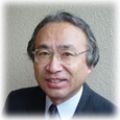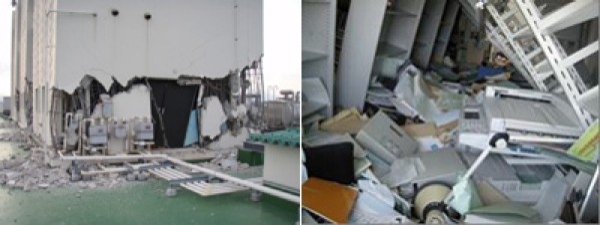Longtime semiconductor exec Takeshi Hattori has been reporting exclusively for SST on the aftermath of the massive Japanese earthquake and tsunami, with updates on the nuclear crisis, status of facilities and production struggles. See his previous updates here, here, here, here, here, and here.
 May 11, 2011 – Two months have passed since the March 11 earthquake/tsunami disaster. The death toll reached 15,000, most of them drowning victims of the unexpectedly massive tsunami. Nobody died or was seriously injured by the nuclear radiation from unstable Fukushima Daiichi nuclear plant. Still, approximate 10,000 people are listed as missing, most of them washed away in out-going tides of tsunami toward the Pacific Ocean. The huge amount of rubble floating on the sea will come to Hawaii next year, and to the west coast of the US, Canada, and Mexico in 2014.
May 11, 2011 – Two months have passed since the March 11 earthquake/tsunami disaster. The death toll reached 15,000, most of them drowning victims of the unexpectedly massive tsunami. Nobody died or was seriously injured by the nuclear radiation from unstable Fukushima Daiichi nuclear plant. Still, approximate 10,000 people are listed as missing, most of them washed away in out-going tides of tsunami toward the Pacific Ocean. The huge amount of rubble floating on the sea will come to Hawaii next year, and to the west coast of the US, Canada, and Mexico in 2014.
Another nuclear plant to shut down for safety; Semiconductor fabs upset
Dangerous work to stabilize GE/Toshiba/ Hitachi-made reactors at Fukushima Daiichi nuclear plant of Tokyo Electric Power Co. continues day and night. Additionally, upon a very strong request by Prime Minister Naoto Kan for safety reasons, Nagoya-based Chubu Electric Power Co. finally agreed Monday (May 9) to suspend operation of Hamaoka nuclear plant located on the coast of Pacific Ocean in Shizuoka Prefecture in a few days. The plant is located in the focal region of the "Great Tokai earthquake," a Magnitude 8 or bigger quake expected to occur with a probability of 87% in the coming 30 years or so, according to the prime minister.
Chubu Electric Power Co. may barely meet peak demand this summer, even if Hamaoka nuclear plant shuts down, by increasing power output at its thermal plants to make up for lost capacity of the three reactors at Hamaoka. If this summer is hotter than usual, however, power outages may occur. It remains unclear whether the firm can obtain electricity from Osaka-based Kansai Electric Power Co. and other electric power companies in West Japan.
Chubu Electric said it will be difficult to continue supplying electricity to Tokyo Electric Power Co. This will create additional power shortage issues in the greater Tokyo area and Kanto Plain, home of Renesas’s Naka Factory and SEH’s Annaka Factory.
The service area of Chubu Electric is greater Nagoya and central Japan, within which are Toyota Motor’s main automobile plants (Toyoda, Aichi Prefecture) and Toshiba’s and Fujitsu’s main semiconductor plants (both in Mie Prefecture), among others. Now they must start considering how to take countermeasures against anticipated power shortage toward this summer peak.
Japan’s basic energy policy to be reviewed from scratch
Speaking at a news conference on the evening of May 10, Prime minister Kan said Japan needs to review its basic energy policy from scratch while seeking to ensure much safer use of nuclear power as well as pursuing renewable sources such as wind, solar or biomass energy. The current basic energy policy envisages that >50% of total electricity supply will come from nuclear power, and >20% from renewable power in 2030 — "but that basic plan needs to be reviewed now from scratch after this nuclear crisis," he said. "Japan must now put more emphasis on solar and other renewable sources where Japan lags globally." Conserving energy would also be vital to a long-term energy policy. And energy-saving technologies as well as renewable energy development will be expected to greatly advance in a few years with such strong motivations.
Renesas
At Renesas Electronics’ Naka Factory (Hitachi-Naka, Ibaraki Prefecture), a 200mm test-wafer run started on April 23, and 300mm test-wafer run on April 25. As reported previously, the company is preparing for restarting partial production of automotive micro-controllers at their 200mm wafer line "N2"on June 15 — with some 2500 additional support workers dispatched from automobile companies such as Toyota and Honda and electronics firms (their parent firms) Mitsubishi and Hitachi, among others, to help early resumption of production. It will take more time to re-start up the 300mm wafer line "N3" than the 200mm line "N2", since the 45nm/300mm equipment and processes are more complicated than those for 130nm/200mm. The initial 200mm wafer input on June 15 and some later would be a 3000 wafers-a-month level, only less than 10% of the full capacity of 34,000 wafers per month. They expect to resume partial production at their 300mm line "N3"sometime within this July, but initial production level will be again much less than the full capacity of 14,000 wafer per month. Some of 300mm production of application processors for mobile phones has already been shifted to TSMC in Taiwan.
The updated recovery schedule will officially be announced in mid-May, but company sources indicate production capacity at both the 200mm and 300mm wafer fabs will never return to the pre-earthquake levels — they have been shifting production to their other factories in Japan as well as to foundries overseas. The final recovery level at the Naka Plant will be probably 50% or so of the pre-earthquake level, according the sources. Renesas decided last year to become fab-lite in the near future by giving up their own production of advanced devices beyond 32nm by using TSMC and GlobalFoundries as their foundries.
Renesas reported on May 10 that annual sales for FY2010 (April 2010-March 2011) was ¥1.137 trillion (US $14.2B), up 7% from the previous year. Operating profit was ¥14.5B ($181M). Net loss was ¥115B ($1.4B) including a ¥50 B loss from the earthquake.
Toshiba
Toshiba Corp. in Tokyo reported total sales for FY2010 of ¥6.3895 trillion (US $80 B), up 1.7% from the previous year; sales from the electronic device sector were ¥1.3477T ($16.85B),up 6.1% from the previous year. Operation profit was ¥240.3 B ($3B), up 92%, which included ¥86.8B ($1.1B) from the electronic device sector. They expects total operating profit to rise by 25% in the current business year (April 2011-March 2012), but warned that potential power outages could change that outlook.
The shutdown of the Hamaoka nuclear plant could affect electricity supplies and disrupt production at Toshiba’s Yokkaichi plant, which has five fabs for volume producing NAND flash memory chips jointly with SanDisk of the US. Fumio Muraoka, Toshiba SEVP, said he could not comment on the impact of such a shutdown without more information on when it would occur, how far Chubu Electric could rely on thermal plants, and how much Chubu Electric can buy electric power from Kansai Electric, etc.
Toshiba also faces risks in its own nuclear reactor business, but they will put more emphasis on thermal power station business this year. Toshiba announced on May 10 that it has signed a memorandum of understanding with Cock Power Generation Group Inc., a business unit of The Babcock & Wilcox Company (B&W), a US-based leading global supplier of power generation equipment, to enhance their cooperation on strategic project opportunities in the thermal power generation business.
Fujitsu
Fujitsu’s semiconductor plants in Iwate and Aizu-Wakayama in East Japan have already resumed operation , but some 30% of production volumes were shifted to the Fujitsu’s main semiconductor base in Mie Prefecture, in anticipation power shortage and aftershocks affecting Fujitsu’s two plants in Tohoku District. Now, the firm must worry about power shortage in Mie and some countermeasures must be taken. A top executive of Fujitsu said that they can not catch up with the sudden new energy situation.
Tohoku University
Tohoku University, a distinguished national university in Sendai, Miyagi Prefecture — near the epicenter — very recently reported some ¥80B ($1B) in damage by the earthquake/tsunami, including ¥44B ($550M) in building damage and ¥35B ($44M) in equipment damage. Some 7,000 units of research tools had damage, including ¥1.3B ($16M) worth of accelerators for atomic physics research. Twenty-eight school buildings were seriously damaged and cannot be used again, of which 16 buildings outside the main campus were destroyed by tsunami. Three students died in the tsunami and some 500 students lost their houses. The university’s new school year started on May 6, one month later than usual.
 |
| Outside (left) and inside (right) of a building, School of Engineering, Tohoku University, Sendai, Japan, just after the March 11 earthquake. Most engineering buildings are located on the Aobayama Hill so there was no damage by tsunami but severe damage by massive shakes. (Image courtesy of Tohoku University). |
Takeshi Hattori is president of Hattori Consulting International and editorial columnist of Electronic Journal in Japan, with more than 36 years experience in the semiconductor field. He is a Fellow of the Electrochemical Society, founding member of the International Symposium on Semiconductor Manufacturing, member of SEMI’s Japan regional standards committee and SEMI/SEAJ Forum, and The Confab advisory board, among many others.

